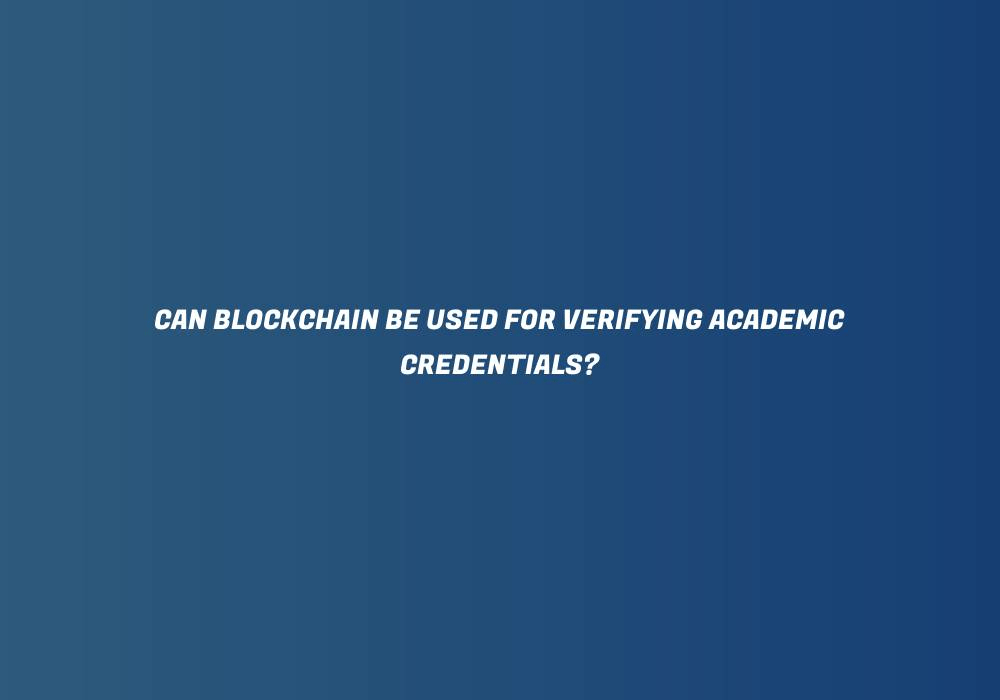You have probably heard of blockchain technology in relation to cryptocurrencies like Bitcoin, but did you know that it has the potential to revolutionize the way we verify academic credentials? Blockchain, a distributed ledger system that ensures transparency and trustworthiness, could provide a secure and efficient way to authenticate degrees, certificates, and diplomas. By implementing blockchain technology, educational institutions and employers can verify the authenticity of academic credentials easily and quickly, saving time and reducing the risk of fraudulent claims. In this article, we will explore the possibilities and benefits of using blockchain for verifying academic credentials.
Understanding Blockchain
Blockchain technology has gained significant attention in recent years for its potential to revolutionize various industries. At its core, blockchain is a decentralized, digital ledger that securely records transactions across multiple computers. This advanced technology offers numerous benefits, including transparency, immutability, and increased security. To understand how blockchain can be used for verifying academic credentials, we must first grasp the fundamental principles behind it.
What is blockchain?
Blockchain is a digital ledger that consists of a chain of blocks, each containing a list of transactions. Unlike traditional centralized systems, blockchain operates on a decentralized network of computers, known as nodes. Every transaction made on the blockchain is verified and recorded by these nodes, ensuring transparency and trust. The information stored on the blockchain is tamper-resistant, as each block contains a unique cryptographic hash that is generated based on the data within it.
How does blockchain work?
When a transaction is initiated on the blockchain, it is bundled with other transactions into a block. Before this block can be added to the chain, it must be verified by the network of nodes through a consensus mechanism, such as proof-of-work or proof-of-stake. Once consensus is reached, the block is added to the chain and becomes a permanent part of the ledger. The decentralized nature of blockchain ensures that no single entity has control over the entire network, making it highly resistant to tampering and fraud.
Benefits of blockchain
Blockchain offers several advantages over traditional verification methods. Firstly, its decentralized nature eliminates the need for intermediaries, such as certificate-issuing authorities or credential verification services. This reduces costs and eliminates the potential for human error or bias. Additionally, blockchain provides a transparent and immutable record of credentials, making it easier for employers or educational institutions to verify their authenticity. Lastly, blockchain’s cryptographic security measures enhance the privacy and security of sensitive data, ensuring that only authorized parties can access the information.
Issues with Traditional Verification Methods
Before delving into the application of blockchain in verifying academic credentials, it is crucial to understand the shortcomings of traditional verification methods. Paper-based credentials and reliance on centralized databases pose significant challenges and leave room for fraud.
The problem with paper-based credentials
Traditionally, academic credentials, such as diplomas or transcripts, are issued in paper form. While these documents may seem official, they are easily susceptible to forgery and tampering. Counterfeit degrees have become a prevalent issue, compromising the credibility of educational institutions and the value of legitimate degrees. Moreover, the physical storage and handling of paper documents create logistical challenges and increase the risk of loss or damage.
Challenges of relying on centralized databases
In an attempt to address the weaknesses of paper-based credentials, many organizations have turned to centralized databases for storage and verification. However, this approach has its own set of challenges. Centralized databases are vulnerable to hacking, data breaches, and manipulation. Unauthorized access to these databases can lead to identity theft or the creation of fake credentials. Additionally, relying on a single point of failure poses a significant risk, as the loss or corruption of data could have severe consequences.
Case studies of fraudulent credentials
Numerous cases of fraudulent academic credentials have made headlines in recent years. For instance, in 2015, a high-ranking official at a renowned U.S. university was discovered to have falsified his academic credentials, resulting in his resignation. Similarly, in 2017, a prestigious Indian university found that over 400 fake degrees had been issued by a syndicate. These cases highlight the inherent vulnerabilities in traditional verification methods and the need for more secure and reliable systems.
Blockchain for Academic Credentials
Recognizing the limitations of traditional verification methods, blockchain technology presents a promising solution for the verification of academic credentials. By leveraging the unique properties of blockchain, such as transparency, immutability, and decentralization, academic institutions can revolutionize how they authenticate degrees and transcripts.
What is blockchain-based verification?
Blockchain-based verification involves storing academic credentials on a blockchain, thereby creating an indelible digital record of each credential’s authenticity. These records can include information such as the name of the recipient, the name of the issuing institution, the date of issuance, and any additional relevant details. By adopting blockchain-based verification, educational organizations can establish a decentralized and tamper-proof system for validating and sharing academic credentials.
How can blockchain verify academic credentials?
To verify academic credentials using blockchain, a unique identifier is created for each credential. This identifier is then linked to the corresponding digital record on the blockchain. Whenever someone requests verification of a specific credential, the blockchain can be queried to retrieve and verify its details. This ensures that the information provided is accurate and has not been tampered with. By eliminating the need for intermediaries, blockchain-based verification reduces the time and cost associated with traditional verification processes.
Advantages of using blockchain for verification
Blockchain-based verification offers numerous advantages over traditional methods. Firstly, the decentralized nature of blockchain ensures that credentials are stored securely, reducing the risk of fraud or alteration. The transparency of the blockchain allows for easy and quick verification of credentials, streamlining the hiring or admission processes. Additionally, blockchain-based verification provides a higher level of privacy by allowing individuals to control access to their academic records. This empowers individuals to share their credentials selectively, preventing unauthorized access.
